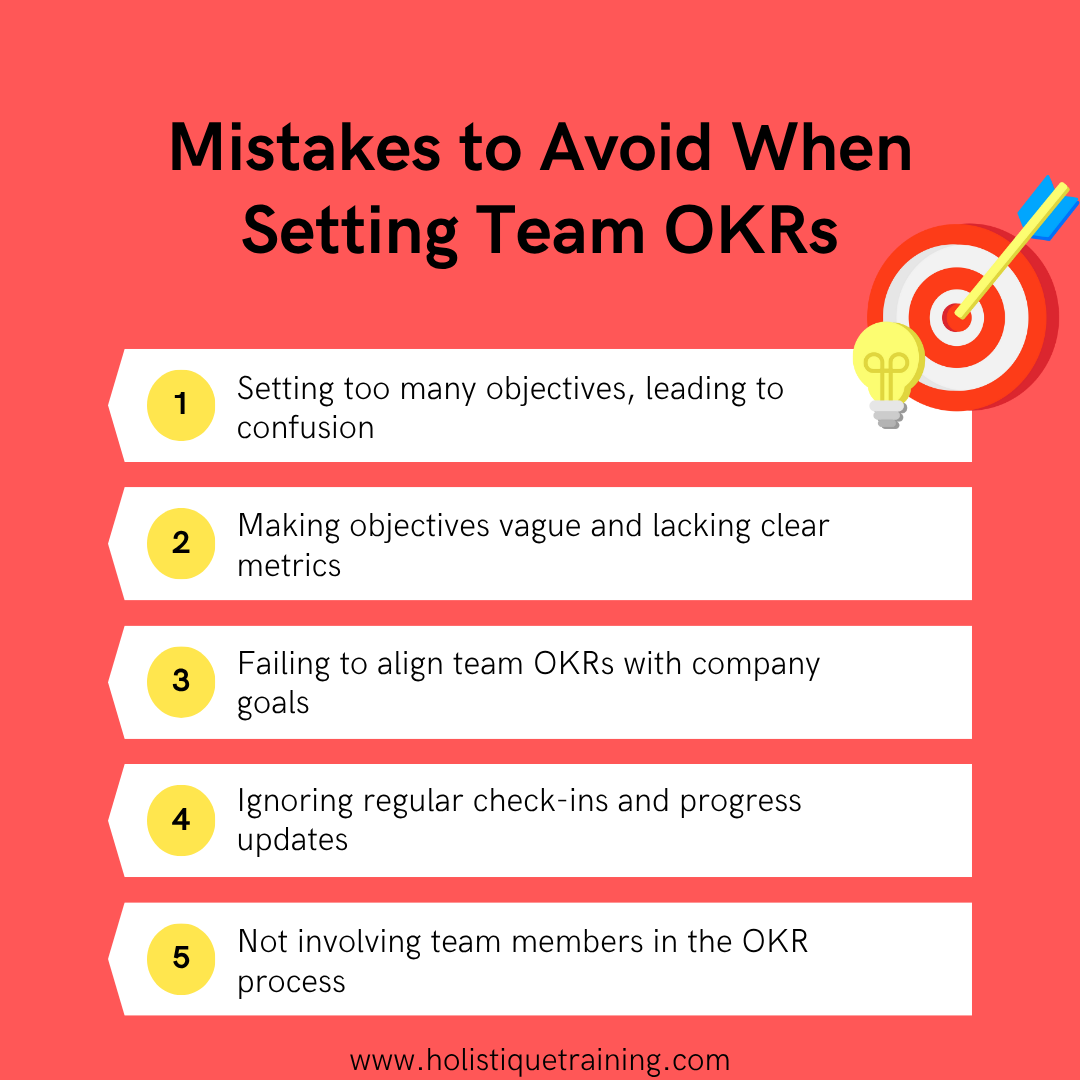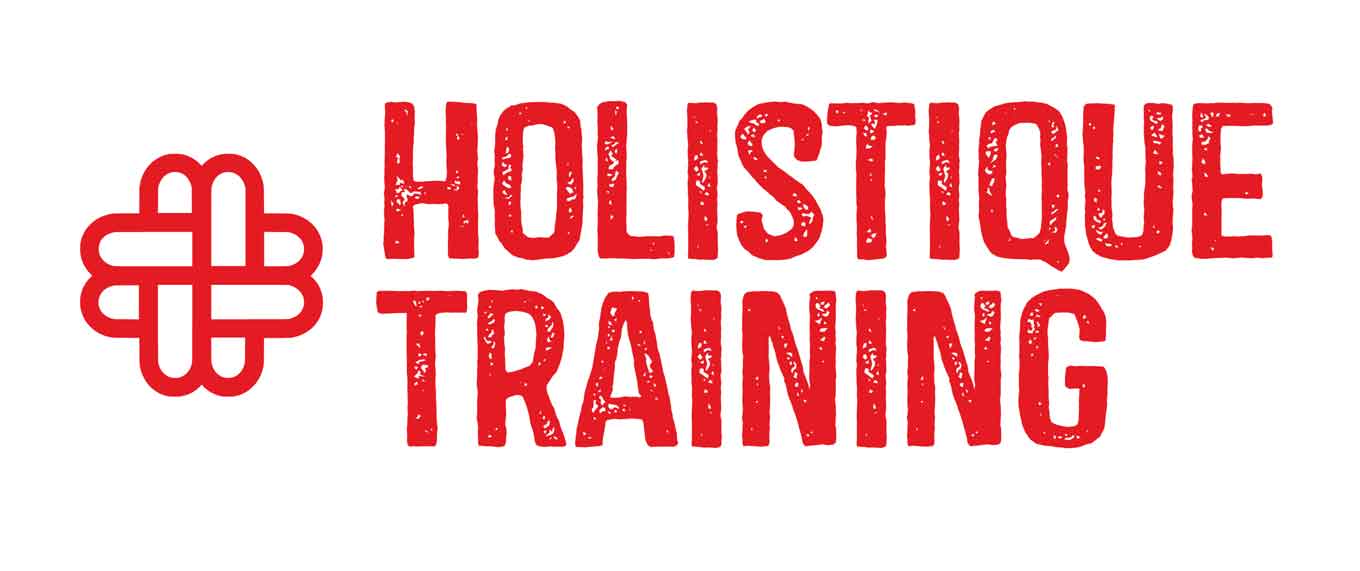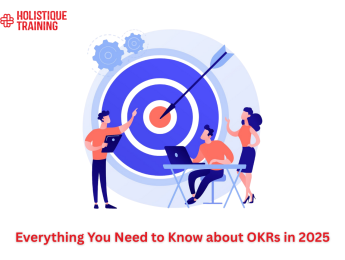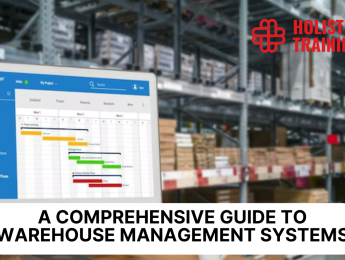- Table of Contents
- Introduction
- What are Objectives and Key Results (OKRs)?
- The Structure of OKRs
- What Makes a Good OKR?
- 1. Clarity
- 2. Ambition
- 3. Measurability
- 4. Alignment
- 5. Time-Bound
- 6. Simplicity
- 7. Flexibility
- 8. Engagement
- Types of OKRs
- Committed OKRs:
- Aspirational OKRs:
- Learning OKRs:
- Why Are OKRs Important in Business?
- Alignment Across Teams
- Enhanced Focus and Prioritization
- Increased Accountability
- Agility and Adaptability
- Employee Engagement and Motivation
- Improved Performance Measurement
- Encouragement of Innovation
- Cultivation of a Growth Mindset
- Facilitating Communication and Collaboration
- OKRs vs. Other Goal-Setting Methodologies
- Key Differences Explained
- How Many Objectives and Key Results Should a Team Set?
- Steps to Get Started with an OKR Framework
- 1. Educate the Team
- 2. Define Organizational Goals
- 3. Collaborate on OKRs
- 4. Draft OKRs
- 5. Communicate and Align
- 6. Monitor Progress
- 7. Reflect and Iterate
- The Role of AI in OKR Setting
- Data Analysis:
- Performance Tracking:
- Predictive Insights:
- Personalization:
- Continuous Feedback:
- Conclusion
Introduction
Setting and achieving goals is fundamental to the success of any organization. With the rapid pace of change in today's business landscape, traditional goal-setting methods often fall short, leaving teams struggling to align their efforts with broader organizational objectives. Enter Objectives and Key Results (OKRs), a framework that is revolutionizing how teams define and pursue their goals. This blog post will explore the concept of OKRs, their significance in business, and how they differ from other goal-setting methodologies. We will also discuss practical steps for implementing OKRs and the role of artificial intelligence in enhancing this process.
What are Objectives and Key Results (OKRs)?
Objectives and Key Results, commonly known as OKRs, is a goal-setting framework that helps organizations define their objectives and track their outcomes. The concept was popularized by companies like Intel and Google, which have used it to drive performance and align teams around common goals.
The Structure of OKRs
OKRs consist of two main components:
- Objectives: These are qualitative, ambitious goals that provide direction and inspiration. An objective should be clear, concise, and engaging, motivating teams to strive for excellence.
- Key Results: These are measurable outcomes that indicate progress toward achieving the objective. Key Results should be quantitative and time-bound, providing a clear metric for success.
For example, an objective might be "Improve customer satisfaction," while the key results could include "Achieve a Net Promoter Score (NPS) of 70" or "Reduce customer support response time to under 2 hours."
What Makes a Good OKR?
Crafting effective OKRs is crucial for ensuring that teams remain focused, motivated, and aligned with organizational goals. A well-structured OKR can serve as a powerful tool for driving performance and fostering a culture of accountability. Here are some key characteristics that define a good OKR:
1. Clarity
A good OKR should be easy to understand. Team members must grasp the objective and key results without confusion. Clear language helps eliminate ambiguity, allowing everyone to know exactly what is expected. For instance, instead of stating an objective like "Increase sales," a clearer objective would be "Increase quarterly sales revenue by 20%." This specificity provides a concrete target that the team can rally around.
2. Ambition
Objectives should challenge teams to stretch their capabilities and think creatively. A good OKR pushes individuals and teams beyond their comfort zones, inspiring them to innovate and explore new possibilities. For example, an ambitious objective might be "Become the market leader in customer experience within six months." While achieving such a goal may be difficult, it encourages teams to adopt bold strategies and think outside the box.
3. Measurability
Key Results must be quantifiable, allowing teams to track progress and determine success. This measurement fosters accountability and transparency. For instance, instead of a vague key result like "Improve customer satisfaction," a measurable key result would be "Achieve a Net Promoter Score (NPS) of 70." This clarity in measurement allows teams to assess their performance objectively and make data-driven decisions.
4. Alignment
OKRs should align with the organization's overall mission and vision, ensuring that all teams are working towards shared goals. When individual and team OKRs are aligned with broader organizational objectives, it creates a sense of unity and purpose. Researchshows thatorganizations with strong alignment experience revenue growth that is 58% faster and achieve 72% higher profitability compared to those that lack alignment. An example of alignment would be: if a company's mission is to enhance sustainability, a relevant team objective could be "Reduce product waste by 30% this quarter." This alignment not only motivates teams but also reinforces the organization's strategic direction.
5. Time-Bound
Setting a timeframe for achieving OKRs encourages teams to prioritize their tasks and maintain momentum. Time-bound objectives create a sense of urgency and help teams focus on immediate actions. For instance, an objective like "Launch a new feature" becomes more actionable when framed as "Launch a new feature by the end of Q2." This time constraint drives teams to develop concrete plans and milestones, ensuring that progress is made consistently.
6. Simplicity
While ambition is important, simplicity should not be overlooked. Good OKRs are straightforward and avoid unnecessary complexity. Teams should be able to articulate their objectives and key results succinctly, making it easier for everyone to remember and stay focused. A simple OKR structure enhances communication and reduces the risk of misunderstandings.
7. Flexibility
The ability to adapt is vital in today's fast-paced business environment. A good OKR framework allows for flexibility, enabling teams to reassess and modify their objectives and key results as circumstances change. This adaptability ensures that teams remain relevant and responsive to new challenges or opportunities. For example, if a market shift occurs, teams can adjust their key results to reflect new priorities without losing sight of their overarching objectives.
8. Engagement
Finally, good OKRs should foster engagement among team members. Involving employees in the goal-setting process encourages ownership and accountability. When team members contribute to defining their OKRs, they are more likely to be invested in achieving them. This engagement can be further enhanced by regularly discussing progress and celebrating achievements, creating a positive feedback loop that motivates ongoing effort.
By incorporating these characteristics into the OKR-setting process, organizations can create a robust framework that drives performance, aligns teams, and fosters a culture of continuous improvement. Effective OKRs not only help teams achieve their goals but also contribute to the overall success and agility of the organization as a whole.
Types of OKRs
OKRs can be categorized into three primary types, each serving a different purpose:
Committed OKRs:
These are the goals that teams commit to achieving within a specific timeframe. Committed OKRs are often tied to performance evaluations and are crucial for driving accountability. For example, a sales team may commit to achieving a certain revenue target by the end of the quarter.
Aspirational OKRs:
These goals are designed to push teams beyond their comfort zones. Aspirational OKRs are ambitious and may not always be fully achieved, but they encourage innovation and creativity. For instance, a marketing team might set an aspirational OKR to "Launch a viral campaign that reaches 1 million views."
Learning OKRs:
These focus on personal and team development rather than specific outcomes. Learning OKRs help teams explore new skills or methodologies and can include objectives like "Attend three industry conferences" or "Complete a certification course."
Why Are OKRs Important in Business?
The adoption of OKRs offers several benefits that can significantly enhance organizational performance. In fact, according to Mooncamp's 2022 survey, 83% of companies believe that OKRs positively influence their organization.:
Alignment Across Teams
One of the most critical benefits of OKRs is their ability to foster alignment across various teams and departments within an organization. By establishing clear objectives that connect to the broader organizational goals, OKRs ensure that everyone is working towards the same vision. This alignment reduces the likelihood of siloed efforts, where teams operate independently without considering how their work impacts others. When teams understand how their objectives contribute to the company’s mission, collaboration improves, leading to more cohesive efforts and better overall outcomes.
Enhanced Focus and Prioritization
In a fast-paced business environment, it can be challenging for teams to maintain focus on what truly matters. OKRs help organizations prioritize their initiatives by limiting the number of objectives to a manageable few. This focus allows teams to concentrate their efforts on high-impact activities rather than spreading themselves too thin across numerous tasks. For instance, by setting 1 to 3 key objectives per quarter, teams can dedicate their resources and attention to achieving those goals, resulting in higher productivity and more significant progress.
Increased Accountability
OKRs promote a culture of accountability within organizations. By clearly defining objectives and measurable key results, team members understand what is expected of them and how their performance will be evaluated. This transparency creates a sense of responsibility, as individuals and teams are held accountable for their contributions to the organization’s goals. Regular check-ins and progress reviews further reinforce this accountability, encouraging teams to stay on track and make necessary adjustments to their strategies.
Agility and Adaptability
The business landscape is constantly evolving, and organizations must be able to adapt quickly to changing circumstances. OKRs facilitate this agility by allowing teams to reassess their goals regularly, typically on a quarterly basis. This iterative approach enables organizations to pivot in response to market shifts, emerging opportunities, or unforeseen challenges. For example, if a new competitor enters the market, teams can adjust their OKRs to focus on strategies that enhance their competitive advantage. This flexibility ensures that organizations remain relevant and responsive to their environment.
Employee Engagement and Motivation
Involving employees in the goal-setting process can significantly enhance engagement and motivation. When team members have a say in defining their objectives, they are more likely to feel a sense of ownership and commitment to achieving them. OKRs encourage participation and collaboration, fostering a culture where employees feel valued and heard. Additionally, the ambitious nature of OKRs can inspire teams to push their boundaries and strive for excellence, leading to increased job satisfaction and motivation.
Improved Performance Measurement
OKRs provide a clear framework for measuring performance and tracking progress over time. By establishing specific key results that are quantifiable, organizations can assess how well they are achieving their objectives. This data-driven approach enables teams to identify areas of success and areas needing improvement. Regularly reviewing key results allows for timely adjustments to strategies, ensuring that teams remain aligned with their goals and can respond effectively to any challenges that arise.
Encouragement of Innovation
The aspirational nature of OKRs encourages teams to think creatively and innovate. By setting ambitious objectives, organizations create an environment where experimentation and risk-taking are valued. This culture of innovation can lead to the development of new products, services, or processes that drive growth and competitive advantage. For example, a tech company might set an aspirational OKR to "Develop a groundbreaking AI feature," prompting teams to explore cutting-edge technologies and solutions that could redefine their offerings.
Cultivation of a Growth Mindset
Implementing OKRs fosters a growth mindset within organizations. By encouraging teams to set challenging goals and embrace learning opportunities, OKRs promote continuous improvement and development. Teams are more likely to view setbacks as learning experiences rather than failures, creating a culture that values resilience and adaptability. This mindset not only enhances individual and team performance but also contributes to the long-term success of the organization.
Facilitating Communication and Collaboration
OKRs enhance communication andcollaboration within organizations by providing a common language for discussing goals and progress. Regular check-ins and updates on OKRs encourage open dialogue among team members and between departments. This communication fosters a collaborative environment where teams can share insights, challenges, and best practices, ultimately driving better outcomes. When everyone is aware of each other’s objectives, it becomes easier to identify opportunities for collaboration and support.
In summary, the importance of OKRs in business cannot be overstated. They provide a structured framework for aligning goals, enhancing focus, and fostering accountability while promoting agility and innovation. By adopting OKRs, organizations can create a culture of engagement and continuous improvement that drives performance and success. In a competitive landscape where adaptability and collaboration are essential, OKRs serve as a valuable tool for navigating the complexities of modern business.
OKRs vs. Other Goal-Setting Methodologies
While OKRs are a popular framework, they are not the only method for setting goals. Here’s a comparison of OKRs with other common goal-setting methodologies:
Feature | OKRs | SMART Goals | KPIs |
Structure | Objectives + Key Results | Specific, Measurable, Achievable, Relevant, Time-bound | Key Performance Indicators |
Focus | Alignment and ambition | Clarity and feasibility | Performance measurement |
Timeframe | Quarterly or annual | Flexible | Ongoing |
Ambition | Aspirational and committed | Realistic | Generally not aspirational |
Flexibility | High | Moderate | Low |
Key Differences Explained
- Structure: OKRs combine qualitative objectives with quantitative key results, while SMART goals focus solely on the clarity and feasibility of individual goals. KPIs are metrics used to assess performance rather than goals themselves.
- Focus: OKRs emphasize alignment and ambition, encouraging teams to set challenging goals. In contrast, SMART goals prioritize clarity and achievability, which can sometimes lead to conservative goal-setting. KPIs are focused on measuring performance against established benchmarks.
- Timeframe: OKRs typically operate on a quarterly or annual cycle, allowing for regular reassessment, whereas SMART goals can be set for various timeframes depending on the context. KPIs are often ongoing metrics that do not have a defined end date.
- Ambition: OKRs encourage teams to set aspirational goals that may stretch their capabilities, while SMART goals tend to be more realistic and achievable. KPIs are generally not designed to be aspirational but rather serve as indicators of performance.
- Flexibility: The OKR framework is highly flexible, allowing teams to adjust their objectives and key results as needed. SMART goals have moderate flexibility, while KPIs are typically more rigid and focused on continuous measurement.
Here are some examples of OKRs and KPIs that will help you differentiate between both:
Objectives and Key Results (OKRs) | Key Performance Indicators (KPIs) |
Increase customer satisfaction by 20% this quarter. | Customer satisfaction score (CSAT) percentage. |
Launch three new products by the end of Q2. | Number of products launched per quarter. |
Improve team efficiency by reducing project completion time by 15%. | Average project completion time in days. |
Expand market presence in two new regions this year. | Market share percentage in targeted regions. |
Enhance employee engagement to achieve a 90% response rate. | Employee engagement survey participation rate. |
How Many Objectives and Key Results Should a Team Set?
Determining the appropriate number of OKRs is essential for maintaining focus and effectiveness. While there is no one-size-fits-all answer, a common guideline is:
- Objectives: Aim for 1 to 3 objectives per team or individual. This limitation encourages teams to concentrate their efforts on a few critical areas rather than spreading themselves too thin.
- Key Results: Each objective should have 2 to 5 key results. This range allows for a comprehensive assessment of progress while avoiding overwhelming teams with too many metrics.
By adhering to these guidelines, teams can maintain clarity and focus, ensuring that their efforts are directed toward achieving meaningful outcomes.
Steps to Get Started with an OKR Framework
Implementing an OKR framework requires careful planning and execution to ensure that it effectively drives performance and aligns teams. Here’s a detailed look at the key steps organizations should follow to get started with OKRs:
1. Educate the Team
Before diving into the OKR process, it’s essential to educate team members about the framework. This foundational step involves providing resources, conducting workshops, and facilitating training sessions that explain the principles and practices of OKRs.
- Workshops and Training: Organize hands-on workshops where teams can learn about the structure of OKRs, the importance of alignment, and how to write effective objectives and key results. Use real-world examples to illustrate successful implementations.
- Resource Materials: Develop or curate resource materials, such as guides, articles, and videos, that team members can refer to as they learn about OKRs. This can include case studies from organizations that have successfully utilized the OKR framework.
- Q&A Sessions: Hold open forums or Q&A sessions where team members can ask questions and clarify any uncertainties about the OKR process. This promotes engagement and ensures that everyone is on the same page.
2. Define Organizational Goals
The next step involves establishing overarching organizational goals that will guide the development of team and individual OKRs. These goals should align with the company’s mission, vision, and strategic priorities.
- Leadership Involvement: Engage leadership in the goal-setting process to ensure that the organizational objectives reflect the company’s long-term vision. Leadership should articulate clear, high-level goals that can inspire teams.
- Stakeholder Input: Consider gathering input from various stakeholders across the organization. This inclusivity fosters a sense of ownership and ensures that the goals resonate with different teams.
- Prioritization: Focus on a limited number of organizational goals to avoid overwhelming teams. Prioritize goals that will have the most significant impact on the organization’s success.
[Developing Your Organisational Skills as an Effective Supervisor course]
3. Collaborate on OKRs
Encouraging collaboration among team members is crucial for developing meaningful OKRs. Teams should work together to create their objectives and key results, fostering a sense of shared ownership.
- Brainstorming Sessions: Organize brainstorming sessions where team members can discuss potential objectives and key results. This collaborative approach can generate diverse ideas and perspectives.
- Drafting and Feedback: Teams should draft their OKRs and then solicit feedback from peers and leadership. This iterative process allows for refinement and ensures that the OKRs are aligned with organizational goals.
- Encourage Participation: Ensure that all team members have the opportunity to contribute to the OKR-setting process. This involvement enhances buy-in and commitment to achieving the goals.
4. Draft OKRs
Once collaboration has taken place, teams should draft their objectives and key results, ensuring they adhere to the principles of clarity, ambition, and measurability.
- SMART Criteria: Apply the SMART criteria (Specific, Measurable, Achievable, Relevant, Time-bound) to evaluate the objectives and key results. This helps ensure that each OKR is well-defined and actionable.
- Focus on Impact: Encourage teams to think about the impact of their objectives. Good OKRs should drive significant results that contribute to the organization’s success.
- Limit the Number: Remind teams to keep their focus by limiting the number of objectives to 1 to 3 and key results to 2 to 5 per objective. This limitation encourages depth over breadth.

5. Communicate and Align
Once OKRs are finalized, it’s essential to communicate them across the organization. This transparency ensures that everyone is aware of the goals and understands how their work contributes to achieving them.
- Company-wide Meetings: Hold company-wide meetings to present the finalized OKRs. This can be an opportunity for leadership to emphasize the importance of alignment and collaboration.
- Documentation: Create a centralized document or platform where all OKRs are recorded and accessible to everyone in the organization. This documentation promotes transparency and accountability.
- Regular Updates: Encourage teams to regularly share updates on their progress toward achieving their OKRs. This ongoing communication keeps everyone informed and engaged.
6. Monitor Progress
Regularly checking in on the progress of OKRs is vital for maintaining momentum and ensuring that teams stay on track. Establishing a routine for monitoring progress helps identify potential challenges early on.
- Weekly or Monthly Check-ins: Schedule regular check-in meetings (weekly or monthly) where teams can review their key results and discuss any obstacles they may be facing. This fosters a culture of accountability and support.
- Use OKR Software: Consider utilizingOKR management software or tools that facilitate tracking and monitoring progress. These platforms can provide visual dashboards and analytics to help teams stay organized.
- Celebrate Milestones: Recognize and celebrate milestones and achievements as teams make progress toward their OKRs. This positive reinforcement boosts morale and encourages continued effort.
7. Reflect and Iterate
At the end of the OKR cycle, conducting a retrospective is essential for evaluating what worked, what didn’t, and how the process can be improved. This reflection fosters a culture of continuous improvement.
- Gather Feedback: Solicit feedback from team members about their experiences with the OKR process. What challenges did they face? What aspects worked well? This feedback is invaluable for refining future OKR cycles.
- Analyze Results: Review the outcomes of the OKRs to assess overall performance. Did the teams achieve their objectives? What were the key learnings? This analysis informs future goal-setting efforts.
- Make Adjustments: Based on the feedback and analysis, make necessary adjustments to the OKR process for the next cycle. This iterative approach ensures that the framework evolves and remains effective.
By following these steps, organizations can effectively implement an OKR framework that drives performance, fosters alignment, and enhances collaboration. The successful adoption of OKRs not only helps teams achieve their goals but also contributes to a culture of transparency, accountability, and continuous improvement. As organizations navigate the complexities of modern business, a well-structured OKR process can serve as a powerful tool for achieving success.
The Role of AI in OKR Setting
Artificial intelligence is increasingly influencing how organizations approach goal-setting, including the OKR framework. Here are some ways AI can enhance the OKR process:
Data Analysis:
AI can analyze historical performance data to identify trends and suggest realistic key results based on past achievements. This analysis helps teams set informed and achievable goals.
Performance Tracking:
AI-powered tools can automate the tracking of key results, providing real-time insights into progress. This automation reduces the administrative burden on teams and allows them to focus on achieving their objectives.
Predictive Insights:
AI can offer predictive insights into potential challenges or obstacles that teams may face in achieving their OKRs. By identifying these risks early, teams can proactively develop strategies to address them.
Personalization:
AI can help tailor OKRs to individual team members based on their strengths, weaknesses, and past performance. This personalization can enhance engagement and motivation.
Continuous Feedback:
AI-driven platforms can facilitate continuous feedback loops, allowing teams to receive real-time input on their progress and make adjustments as needed.
By leveraging AI in the OKR process, organizations can enhance their goal-setting practices, improve alignment, and drive better outcomes.
Conclusion
The adoption of OKRs represents a significant shift in how organizations approach goal-setting. By focusing on clarity, ambition, and alignment, OKRs empower teams to define their objectives and measure their progress effectively. The flexibility of the OKR framework allows organizations to adapt to changing circumstances, fostering a culture of agility and innovation.
As businesses continue to navigate an increasingly complex landscape, the importance of effective goal-setting cannot be overstated. OKRs provide a powerful tool for aligning teams, enhancing collaboration, and driving performance. By understanding the principles of OKRs, organizations can reshape their approach to goal-setting and unlock their full potential. With the added support of artificial intelligence, the future of OKRs looks promising, paving the way for even greater achievements in the business world.
























